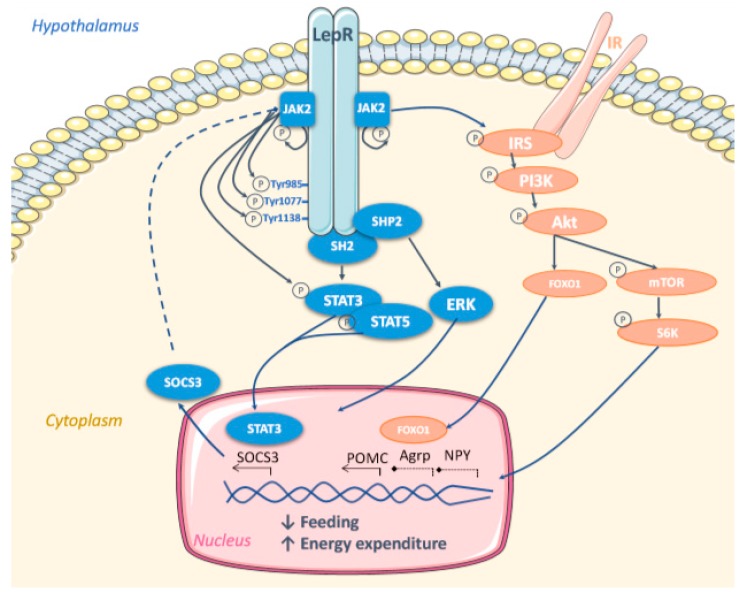Figure 3.
Leptin-induced pathways. The binding of leptin to its receptors (LepR), mainly expressed in the hypothalamus, leads to its dimerization and recruitment and auto-phosphorylation of Janus tyrosine kinase 2 (JAK2). JAK2 subsequently phosphorylates LepR on 3 distinct tyrosine residues (Tyr985, Tyr1077 and Tyr1138), facilitating the binding of Src Homology 2 (SH2) containing molecules. Depending on the phosphorylated tyrosine, different pathways will be activated. Phosphorylation at Tyr985 allows the binding of (i) Suppressor Of Cytokine Signalling 3 (SOCS3) inducing negative feedback to inhibit JAK2 and (ii) SH2 domain protein tyrosine phosphatase 2 (SHP2) to activate Extracellular-signal Regulated Kinase (ERK) pathways. The Tyr1077 permits the phosphorylation and activation of Signal Transducer And Activator of Transcript 5 (STAT5) leading to gene expression changes. Finally, the Tyr1138 allows the phosphorylation of STAT3 altering gene expression and activating SOCS3, reinforcing the negative JAK2 feedback. Furthermore, the leptin pathway is interconnected with the insulin pathway, since JAK2 activation phosphorylates Insulin Receptor (IR) and Substrate (IRS), and subsequently, Phosphatidyl Inositol 3 Kinase (PI3K), protein kinase B (Akt) leading to the activation of Forkhead box protein O1 (FOXO1) and also mammalian Target Of Rapamycin (mTOR)/ribosomal S6 kinase (S6K). Together, all these leptin-activated signalling pathways trigger energy homeostasis gene regulation, mainly consisting in over-transcription of anorexigenic Pro-opiomelanocortin (POMC) and down-transcription of orexigenic Agouti Related Protein (Agrp) and Neuropeptide Y (NPY) neuropeptides, as well as favouring energy expenditure genes, including thermogenic markers.

